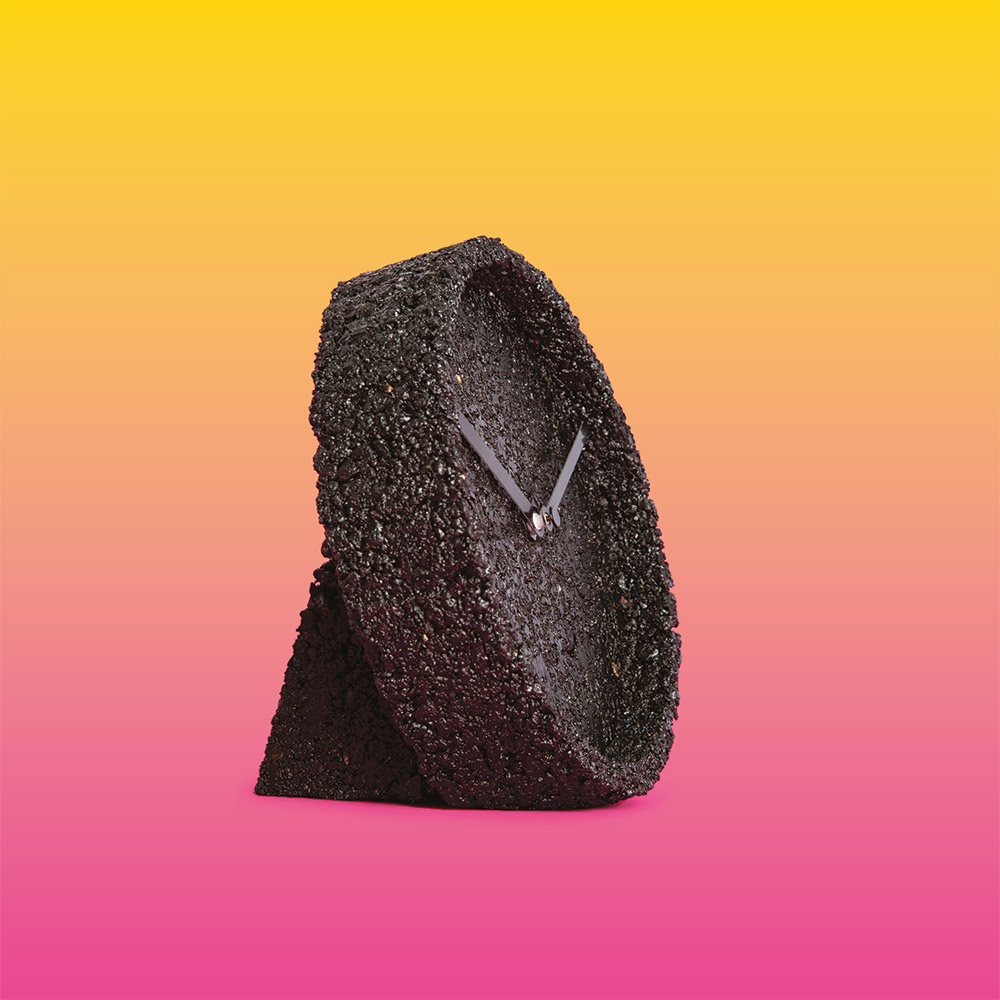Asphalt Clock by Gabriela Chicherio
Asphalt Clock (RU)
„Дороги формируют наш современный, мобильный мир. Большая часть жилого районов закрыта и отдана для транспорта. То, что сегодня критикуется и называется «перегрев городов», изначально было гениальным решением. Швейцарский пульмонолог доктор Эрнест Гульельминетти предложил заделывать дегтем дороги, которые становились все более пыльными из-за увеличения дорожного движения. В 1902 году, согласно его планам, в Монте-Карло были проложены первые 40 метров тротуара. Так швейцарец получил свое прозвище «Доктор гудрон» (по-французски – «деготь»).
Эта история из длинного списка швейцарских изобретений, а также споры о самом материале, показались мне чрезвычайно захватывающими. Поскольку деготь содержит канцерогенные вещества, он была запрещена в Швейцарии с 1991 года, и вместо асфальта использовалась смесь битума и камня.
Асфальт может деформироваться при нагревании. Асфальтовые часы также имеют это свойство. Я нагрела кусок сломанного пола на Цюрихской стройке (Устеристрассе и Ригистрассе) и придала ему другую форму. В результате получились простые, настольные часы насыщенного черного цвета с неправильной и уникальной структурой. Широко обсуждаемый и повсеместно использующийся материал модернизирован и использован повторно, вместо того, чтобы быть просто переработанным. С улицы перемещен в гостиную.
И поэтому кусок асфальта следует понимать как пищу для размышлений, как свидетельство нашего противоречивого мира и как напоминание о том, что наше постоянное ускорение все еще поднимает пыль. Часы тикают.“
Project Description (EN)
„Roads shape our modern, mobile world. A large part of the inhabited area is sealed and left to motorized traffic. What is being criticized today for overheating the cities was originally a stroke of genius. The Swiss pulmonologist Dr. Ernest Guglielminetti proposed to seal the roads, which were becoming increasingly dusty due to increasing road traffic, with tar. In 1902, according to his plans, the first 40 meters of pavement were put in place in Monte Carlo. This is how the Swiss came by his nickname Dr. Goudron (French for tar).
This story from the long list of Swiss inventions, but also the controversy about the material itself, I found enormously exciting. Because tar contains carcinogenic substances, it was banned in Switzerland from 1991 onwards and asphalt, a mixture of bitumen and rock was used.
Asphalt can be deformed with heat. The Asphalt-Clock takes advantage of this property. I heated up broken flooring from Zurich construction sites (Usteristrasse and Rigistrasse) and reshaped it. The result is a simple, deep black table clock with an irregular and unique structure. The controversially discussed and omnipresent material is upgraded – upcycling instead of just recycling. From the street into the living room.
And so the chunk of asphalt is to be understood as food for thought, as a witness to our contradictory world, and as a reminder that our constant acceleration is still kicking up dust. The clock is ticking.“
Projektbeschreibung (DE)
«Strassen prägen unsere moderne, mobile Welt. Ein grosser Teil der bewohnten Fläche ist versiegelt und wird dem motorisierten Verkehr überlassen. Was heute in der Kritik für die Überwärmung der Städte steht, war ursprünglich ein Geniestreich. Der Schweizer Lungenarzt Dr. Ernest Guglielminetti schlug vor, die vom zunehmenden Strassenverkehr immer staubigeren Strassen mit Teer zu versiegeln. 1902 wurde nach seinen Plänen in Monte Carlo ein erster Strassenbelag von 40m geteert. So kam der Schweizer zu seinem Übernamen Dr. Goudron (französisch für Teer).
Diese Geschichte aus der langen Liste von Schweizer Erfindungen, aber auch die Kontroverse um das Material selber, fand ich enorm spannend. Weil Teer krebserregende Stoffe enthält, wurde er ab 1991 in der Schweiz verboten und an dessen Stelle Asphalt verwendet, ein Gemisch aus Bitumen und Gestein.
Asphalt lässt sich mit Wärme verformen. Diese Eigenschaft macht sich die Asphalt-Clock zunutze. Ich habe aufgebrochenen Bodenbelag von Zürcher Baustellen (Usteristrasse und Rigistrasse) erhitzt und neu in Form gebracht. Das Resultat ist eine schlichte, tiefschwarze Tischuhr mit einer unregelmässigen und einzigartigen Struktur. Der kontrovers diskutierte und omnipräsente Werkstoff wird aufgewertet – upcycling statt nur recycling. Von der Strasse in die Stube.
Und so ist das Bröckchen Asphalt als Gedankenanstoss zu verstehen, als Zeuge unserer widersprüchlichen Welt, und als Mahnmahl, dass unsere stetige Beschleunigung noch immer Staub aufwirbelt. Die Uhr tickt.»
Description du projet (FR)
„Les routes façonnent notre monde moderne et mobile. Une grande partie de la zone habitée est laissée au trafic motorisé. Ce qui est aujourd’hui critiqué pour la surchauffe des villes était à l’origine un coup de génie. Le Dr Ernest Guglielminetti, pneumologue suisse, a proposé de goudronner les routes qui devenaient de plus en plus poussiéreuses en raison de l’augmentation du trafic routier. En 1902, selon ses plans, les 40 premiers mètres de chaussée furent mis en place à Monte Carlo. C’est ainsi que le Suisse a reçu son surnom de Dr Goudron.
Cette histoire, qui fait partie de la longue liste des inventions suisses mais aussi de la controverse sur le matériau lui-même, m’a énormément intéressée. Comme le goudron contient des substances cancérigènes, il a été interdit en Suisse à partir de 1991 et, à la place l’asphalte, un mélange de bitume et de roche a été utilisé.
L’asphalte peut être déformée par la chaleur. L’Asphalt-Clock profite de cette propriété. J’ai chauffé des revêtements de sol cassés sur des chantiers de construction à Zurich (Usteristrasse et Rigistrasse) et je les ai refaits. Le résultat est une horloge de table simple, d’un noir profond, avec une structure irrégulière et unique. Ce matériau controversé et omniprésent est valorisé – en le upcyclant au lieu de le recycler. De la rue au salon.
Le morceau d’asphalte doit donc être compris comme une matière à réflexion, comme un témoin de notre monde contradictoire et comme un rappel que notre accélération constante soulève encore de la poussière. L’horloge fait tic-tac“.
Gabriela Chicherio (RU)
Габриэла Кикерио – дизайнер, специализирующийся на концепциях, выставках, мебели и аксессуарах. Она разрабатывает продукты для национальных и международных производителей, работает фрилансером, является соучредителем и со-куратором Цюрихской Биеннале дизайна и возглавляет офис инициативы „Сделано в Цюрихе“.
About (EN)
Gabriela Chicherio is a product designer with a focus on concepts, exhibitions, furniture and accessories. She develops products for national and international manufacturers, works as a freelancer, is co-founder and co-curator of the Design Biennale Zürich and heads the office of the Made in Zürich initiative.
www.chicherio.com
Project Details (EN)
Asphalt clock (2020)
Material: asphalt, clockwork
Size: 18 x 18 x 10 cm
Manufacturer: handmade by Gabriela Chicherio
Edition: first edition of 3 pieces
Inspiration Details (EN)
Inpiration: Pieces of Asphalt
Material: asphalt
Size: various
Manufacturer: from road renovation
Age: unknown


